
views
- Loosen the locking knob at the end of the torque wrench.
- Turn the handle until its top edge lines up with the nearest torque measurement printed on the wrench.
- Spin the top dial so the desired number lines up with the vertical line on the wrench. Add the number on the top dial to the one on the wrench for the total torque.
- Tighten nuts or bolts with your torque wrench until it clicks or stops moving.
Adjusting the Wrench
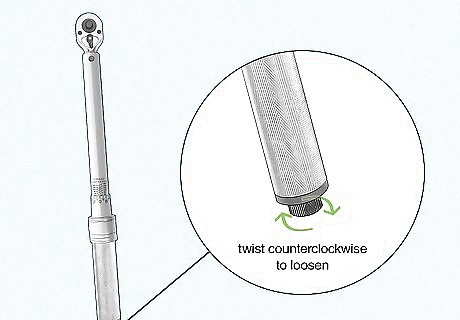
Loosen the locking knob at the end of the wrench’s handle. Look at the end of your torque wrench’s handle to find the metal or plastic locking knob. Twist the locking knob counterclockwise by hand so that you can change the wrench’s settings. Typically, the locking knob is a different color than the rest of your wrench so it’s easy to find. You don’t need to screw the knob off of your wrench; just loosen it until the handle spins easily.

Locate the torque measurements printed on the wrench. Inspect the area just above the handle to find the hash marks printed on the wrench’s main shaft. The horizontal hash marks are usually in increments of 10 or 20 pound force-feet (1.4 or 2.8 kg·m), or foot pounds. Then locate the vertical marks on the top dial of the handle, which go up by 1 lb·ft (0.14 kg·m) increments. Foot pounds or meter kilograms are torque measurements that show how much force is applied over a certain distance. So 1 lb·ft (0.14 kg·m) is the equivalent to 1 pound (0.45 kg) of force over a 1 ft (0.30 m) distance. Most torque wrenches list both foot pounds and meter kilograms on opposite sides of the shaft. If the 2 sets of numbers are listed on the same hash marks, the lower number is the measurement in foot pounds and the larger number is the measurement in meter kilograms.
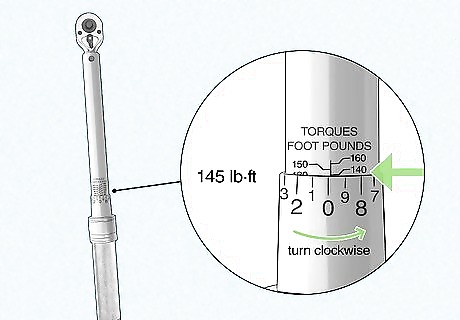
Align the handle’s top edge with the closest approximate torque marking. Hold the body of the wrench with your nondominant hand so it doesn’t move around. Use your dominant hand to turn the handle clockwise to increase the torque or counterclockwise to lower it. Once the top edge of the handle lines up with the horizontal hash mark closest to the torque you need, stop turning the handle.Tip: Refer to your car or bike’s manual to determine how much torque a nut or bolt requires to be safely set. There are no universal rules for torque settings on vehicles. Example: If you need to set the torque to 145 lb·ft (20.0 kg·m), turn the handle until the top lines up with the hash mark for 140 lb·ft (19 kg·m). Some torque wrenches have handles that slide up and down instead of twisting into place. If you have a digital torque wrench, then just use the arrow buttons to increase or decrease the torque setting. Each torque wrench works a little differently, so check the instructions for your specific model.

Twist the top dial on the handle to make precise adjustments. Once you’re close to the desired number, look at the numbers on the top dial of the handle. Slowly turn the dial clockwise to increase the number or rotate it counterclockwise to lower the number. Once the number you want lines up with the vertical line on the wrench, stop spinning the dial. Example: If you need to set the torque to 145 lb·ft (20.0 kg·m) and already have the handle lining up with the 140 lb·ft (19 kg·m) mark, turn the dial so it’s set to 5 lb·ft (0.69 kg·m). On some wrenches, the dial moves independently of the handle and you can twist it by turning it directly rather than using the handle.

Add the digits on the wrench and the dial to determine the total torque. Once you’ve adjusted the handle’s height and twisted the dial, add the numbers together to calculate your total torque and ensure it’s accurately adjusted. To read your torque wrench, find the hash mark that lines up with your handle and add it to the number on the dial lined up with the vertical line. Example: If the handle lines up with the 140 lb·ft (19 kg·m) mark and the dial lines up with the 5 lb·ft (0.69 kg·m) mark, then the total torque setting is 145 lb·ft (20.0 kg·m).

Screw the locking knob back in to lock the setting. Hold the main body of the wrench with your nondominant hand so you don’t accidentally change the torque setting. Then, use your dominant hand to turn the locking knob clockwise until it won’t move anymore. Once you secure the locking knob, you cannot adjust your torque setting until you loosen it again.
Tightening Nuts and Bolts
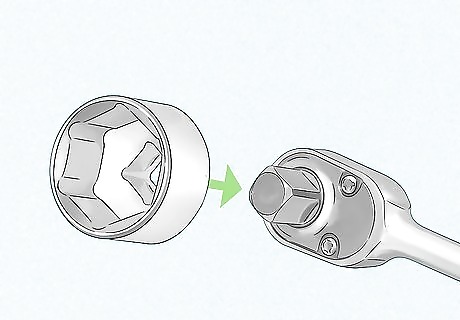
Attach a socket to the head of your wrench. Use a socket that matches the size of your nut or bolt. Slide the end of the socket into the head of your torque wrench until it clicks into place. If you’re tightening a nut or bolt in a hard-to-reach place, attach a socket extender to your wrench first. Torque wrenches come in different sizes, so measure the square head on the end to determine the right socket size.
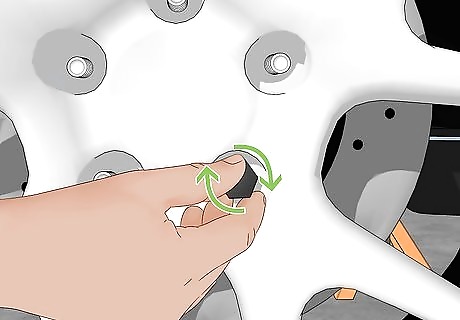
Screw the nut or bolt on by hand until it’s tight. Hold the nut or bolt against the threadings you’re attaching it to, and start turning it clockwise. Keep turning the nut or bolt until you’re not able to rotate it by hand anymore.Warning: Avoid using a torque wrench when you’re first attaching the nut or bolt. Torque wrenches provide a lot of power and if your nut or bolt isn’t perfectly aligned, you could destroy the threadings.

Fit the wrench’s socket over the nut or bolt that you’re tightening. Hold the handle of the torque wrench in your nondominant hand. Use your dominant hand to guide the socket onto the nut or bolt. Make sure the socket fits tightly and doesn’t feel loose. If the socket freely spins without catching on the nut, then use a smaller socket.
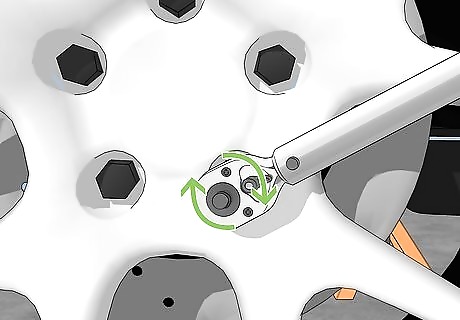
Turn the handle clockwise to tighten the nut or bolt. Rotate the handle clockwise to begin tightening the nut or bolt. Almost all torque wrenches have automatic return functions so you don’t need to reposition them on the nut or bolt. Simply move the handle counterclockwise back to the starting position. If your wrench doesn’t turn counterclockwise, take the socket off the nut or bolt and reposition the wrench. If you hear a clicking or switching noise when you return the handle counterclockwise, you have an automatically-returning torque wrench. Torque wrenches are only made to tighten nuts and bolts, so turning them counterclockwise won’t loosen the fasteners.

Stop turning the wrench when it starts clicking or stops moving. It’s normal for a torque wrench to click if you turn it counterclockwise. If you hear your wrench click loudly when you turn it clockwise, stop turning it since you’ve reached the correct torque setting. On a manual wrench, stop turning it when you feel the wrench resisting. Avoid forcing the wrench any further since you could damage the nut or bolt, or the wrench.
Maintaining Your Wrench
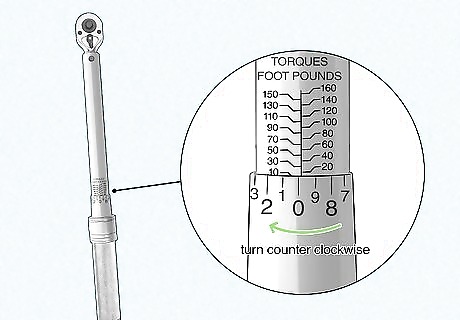
Dial the wrench back to 0 before you put it away. After you finish tightening the nuts or bolts, turn both dial settings on the handle back to 0. Leaving the dial turned to a torque setting higher than 0 can throw off the wrench’s calibration over time and cause it to be inaccurate.

Clean dirty or rusty nuts or bolts before tightening them. Clean the loose rust off of each bolt or nut with a towel or rag before attaching your wrench to them. If there's really stubborn rust, scrub them with a wire brush. Rust and grime could build up inside your sockets and damage your wrench over time since it's harder for your wrench to get a good grip. Torque wrenches aren’t meant to be lubricated, so spray your nut or bolt with a product like WD-40 degreaser before attaching the wrench’s socket.

Have your wrench calibrated at least once a year. While you can calibrate your torque wrench if you have experience working on cars, it’s best to have a mechanic or torque wrench specialist do it for you instead. Every year or when your torque wrench reaches 5,000 clicks, take it in to have it reset so it takes accurate measurements again.Tip: The rule of the thumb is that you need a calibration once a year or once per 5,000 clicks. If you work on cars or bikes every single day, you probably reach 5,000 clicks after 8-10 months. If you’re a DIY enthusiast though, you’re unlikely to hit 5,000 clicks before the year is up. Calibration usually costs between $25-75 USD. If you don’t have your torque wrench calibrated, it may develop a discrepancy between the measurements on your handle and the actual torque of the wrench.
















Comments
0 comment